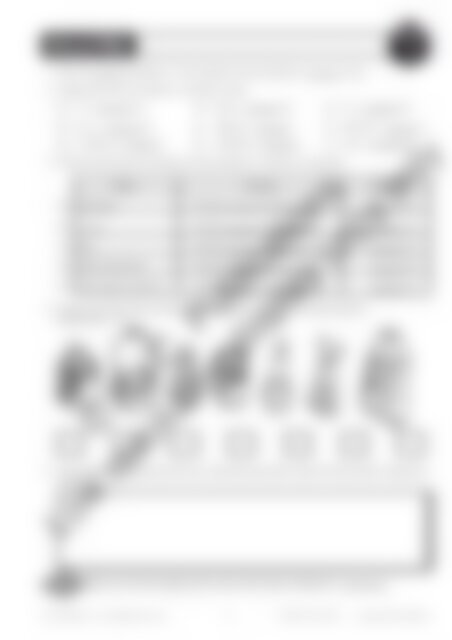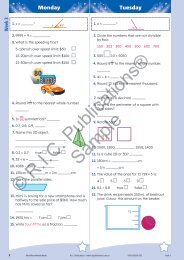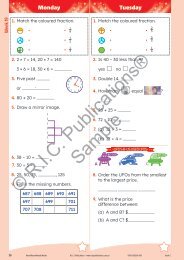3990 Learning at home workbook 6 ebook
You also want an ePaper? Increase the reach of your titles
YUMPU automatically turns print PDFs into web optimized ePapers that Google loves.
MILLILITRES<br />
1. There are millilitres in 1 litre; therefore, there are 500 mL in a litre.<br />
2. Change these litres to millilitres or millilitres to litres.<br />
(a) 3 L = mL (b) 0.25 L = mL (c) 9 L = mL<br />
(d) 6 1 / 2<br />
L = mL (e) 7000 mL = L (f) 8750 mL = L<br />
(g) 15 000 mL = L (h) 25 500 mL = L (i) 9.4 L = mL<br />
3. Estim<strong>at</strong>e and measure the capacity of these containers in millilitres, using w<strong>at</strong>er.<br />
Object Estim<strong>at</strong>e Measured<br />
(a) tablespoon between and mL mL<br />
(b) 1 / 2 cup between and mL mL<br />
(c) mug between and mL mL<br />
(d) small cream bottle between and mL mL<br />
(e) small yoghurt container between and mL mL<br />
4. Compare and order these containers from the smallest capacity to the largest capacity.<br />
Number them 1 to 7.<br />
750 mL<br />
MOO-EE'S<br />
MILK<br />
MOO-EE'S<br />
MILK<br />
2 L<br />
50 mL<br />
375 mL<br />
5. Think about the food and drink items you consumed today. Sketch each item th<strong>at</strong> would be measured in<br />
millilitres.<br />
© R.I.C. Public<strong>at</strong>ions<br />
Low resolution display copy only<br />
500 mL<br />
250 mL<br />
1 Litre<br />
Work out the total capacity of the seven items shown in Question 4.<br />
R.I.C. Public<strong>at</strong>ions® www.ricpublic<strong>at</strong>ions.com.au 107 ISBN 978-1-922313-88-1 <strong>Learning</strong> <strong>at</strong> <strong>home</strong> <strong>workbook</strong> 6


















